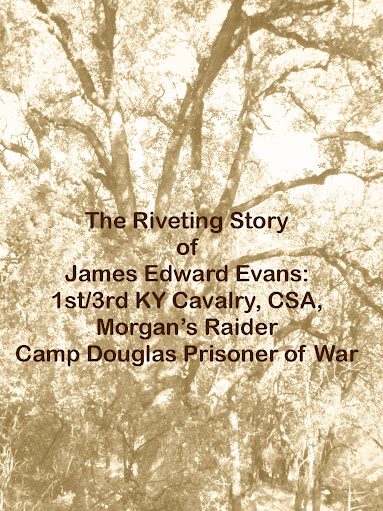October 17, 1862
Morgan never forgave Bragg for retreating after the Battle of Perryville feeling Bragg had behaved as a coward in abandoning the citizens of Kentucky to the ghoulish Northern troops. Morgan and his men remained in Bardstown as Bragg turned tail and ran for the safety of Tennessee.
J. Russell Butler’s 3rd Kentucky and D. Howard Smith’s 5th Kentucky were positioned at Mershon’s Cross Roads near Wild Cat Mountain and charged with covering the Confederate Army’s retreat. [i]
Northern troops marched southward from Louisville.
“As we passed through Louisville in our new uniforms and bright guns with old glory waving at our front the animosity of the secession women was seen by their slurring remarks, about our being Lincoln's hirelings. It so angered Lt. Stebbins that the answer he gave one of them sent her flying into the house."
~ Hiram H. Martin, 29th Indiana Volunteer Infantry, Co. G [ii]
October 18, 1862
Union General Charles Cruft’s Brigade encountered the 1st and 3rd Tennessee and 3rd and 5th Kentucky as they came down Winding Blade Road. A skirmish ensued and the Confederates were forced to retreat from Mershon’s Cross Roads toward Raccoon Creek.[iii]
October 20, 1862
Back in Cox's Creek, Morgan's Confederate Calvary captured a Union supply train consisting of 51 loaded and 31 empty wagons.[iv]
“All but three wagons were destroyed or so badly damaged as to be deemed worthless. Confederates also killed a sick teamster, shot three Federal prisoners, and stole soldiers’ money from plundered mail. Morgan’s depredations provoked the commander at Louisville to keep loaded trains in the city rather than risk having them fall into Rebel hands.”[v]
November 1, 1862- February 28, 1863
James Edward Evans was absent without leave from Capt. H. C. Myres’ Co., Butler’s Regiment, 3rd Kentucky Cavalry.[vi]
Did James, like many other Kentuckians, wished only to fight what he considered the Federal invasion of his native soil? Did he refuse to leave Kentucky? Did James become separated from his Company during the retreat form Mershon’s Crossroads? Did he choose to leave his unit for personal reasons? Did he despair and head for home when faced with freezing weather, lack of food and lack of shelter?
There simply isn’t enough evidence to determine what motivations were in play. Official records are woefully scant. The following is the first and only roll of Company I of the 1st/ 3rd Regiment Cavalry, Kentucky Volunteers.
“Roll of Company I, First Regiment Cavalry, Kentucky Volunteers, Confederate States Army, Reorganization – Consolidated First and Third Regiments
#27 Evans, J. Rank Private, When Enlisted Sep 10, 1863, Where Enlisted Lexington, KY
NOTE: The only roll of this company on file is dated November 1, 1862 to February 28, 1863.”[vii]
Further, it is possible that James Edward Evans may not have been absent at all! The roll may be in error. James may have been transferred to another Company and/or Regiment within the Department of Eastern Tennessee as the Confederate Cavalry began reorganization.
November 1862
The Confederate Cavalry was formally reorganized.
Col. Butler’s 3rd Kentucky Cavalry became an unattached unit under the Department of Eastern Tennessee. Included in this Department was Pegram’s Brigade. [viii]
“The Kentucky Cavalry had been increased, and on the first of November, 1862, Morgan’s cavalry brigade, then in east Tennessee, showed the following organization: Second Kentucky, Col. B. W. Duke; Seventh Kentucky, Col. R. M. Gano; Eight Kentucky, Col. R. S. Cluke; Eleventh Kentucky, Col. D. W. Chenault; Ninth Kentucky battalion, Maj. W. C. P. Breckinridge; Howitzer battery, Captain Arnett. The Ninth battalion, united with Stoner’s battalion, was later raised to a regiment, and its commander became a colonel. The Seventh, Eight, and Ninth regiments had been recruited during the late campaign in Kentucky, and another, the First Kentucky regiment, recruited and reorganized by Col. J. Russell Butler, was temporarily assigned to Colonel Scott’s brigade.”[ix]
History isn't neat and simple. Multifaceted and highly complex, our past is full of surprises, twists, and fascinating subplots. The subplots of the winter were varied: Pegram’s Cavalry leadership or lack there of, Colonel Scott’s open disregard for Pegram, John Hunt Morgan’s instable need for self-aggrandizement. These petty annoyances would simmer all winter, boiling over by spring with disastrous results for James Edward Evans.
ENDNOTES
[i] “War of Rebellion, Official Records of the Union and Confederate Armies” Washington: Government Printing Office 1890 Vol. 16 II, p. 971.
[ii] Martin, Hiram H. "Service Afield and Afloat: A Reminiscence of the Civil War," ed. Guy R. Everson, Indiana Magazine of History 89, no. 1, March 1993, p. 38.
[iii] Hafendorfer, Kenneth A. “They Died By Twos and Tens” 1995 p. 834-835 and 838-839.
[iv] Smith, Z. F. “Kentucky History” pages 193-194.
[v] Taylor, Lenette S. “ The Supply for Tomorrow Must Not Fail,” 2004, p. 87.
[vi] Compiled Military Service Record for James Edward Evans
[vii] McDowell, “The Report of the Adjutant General of the State of Kentucky”, Civil War, Confederate, Vol. I p. 528 – 530.
[viii] Hafendorfer, Kenneth A. “They Died By Twos and Tens” 1995 p. 863.
[ix] Johnson, J. Stoddard. “Confederate Military History of Kentucky, Kentucky During the Civil War”, 2006, Chap 15, p. 121.
Saturday, November 8, 2008
The Confederate Retreat from Kentucky
Subscribe to:
Post Comments (Atom)





No comments:
Post a Comment